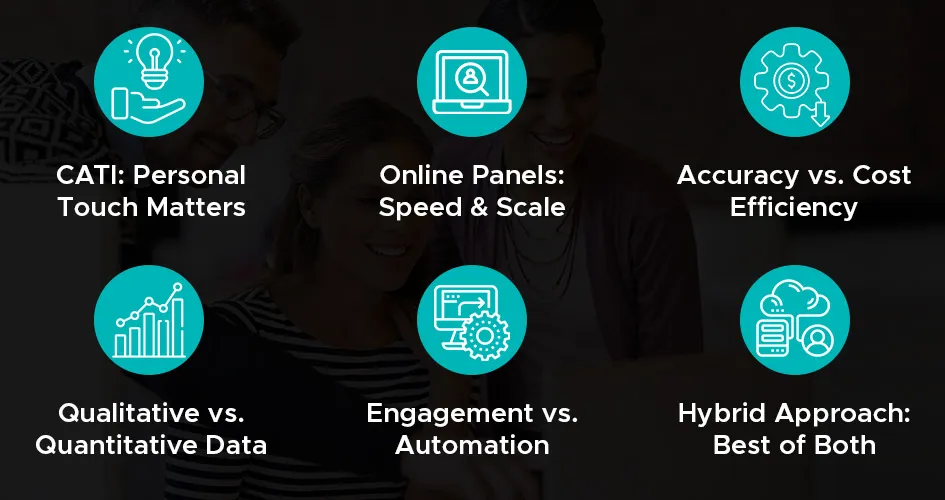
Market research has transformed into a strategic necessity for businesses navigating the ever-changing landscape of healthcare and B2B industries. It’s no longer just about collecting data but about extracting meaningful insights that influence critical decisions. Among the most trusted methods for achieving reliable results are CATI (Computer-Assisted Telephone Interviewing) and Online Panels.
Choosing between these two data collection approaches can be challenging, especially given their unique strengths and applications. In this blog, we’ll break down the differences between CATI and Online Panels, discussing their advantages and limitations to help you determine which method aligns best with your research needs.
In this blog, we’ll delve deep into the CATI vs. Online Surveys debate, analyzing the pros and cons of each approach while sharing real-world insights to help you make an informed choice. By the end, you’ll have a clear understanding of which method is best suited for your healthcare or B2B research needs.
Understanding CATI: What Makes It Unique?
CATI Market Research Services leverage telephone interviews conducted by skilled interviewers who use computer software to record responses. This method is particularly beneficial when collecting complex or sensitive information that requires clarification or follow-up questions.
Key Advantages of CATI:
- Personal Touch: Direct interaction builds rapport, leading to higher response rates.
- Data Accuracy: Skilled interviewers can probe deeper to clarify responses.
- Flexibility: CATI can accommodate changes mid-interview if needed.
- Ideal for Complex Surveys: Suitable for B2B survey panels where in-depth responses are essential.
- Higher Completion Rates: Respondents are more likely to complete interviews when engaged directly.
- Quality Assurance: Supervision and monitoring of calls ensure high-quality data.
However, despite these advantages, CATI Services can be time-consuming and costlier than online methods. The need for skilled interviewers and quality control adds to operational expenses. Additionally, managing large-scale CATI projects may require substantial investment in technology and human resources.
Online Panels: A Modern Approach to Data Collection
As the name suggests, Online Panels involve conducting surveys through a pre-recruited group of respondents who participate in structured questionnaires. This method is highly efficient, cost-effective, and widely used in B2B market research panels.
Key Advantages of Online Panels:
- Cost Efficiency: Eliminates the need for manual interviewing, saving resources.
- Speed: Faster data collection, ideal for rapid decision-making.
- Broad Reach: Easily access diverse demographics and large samples.
- Data Consistency: Uniform questions ensure consistency across responses.
- Scalability: Conduct large-scale studies without geographical limitations.
- Automation: Advanced software can automate data collection and analysis.
However, one challenge with Online Surveys is the risk of lower response accuracy, especially when respondents are not genuinely engaged or motivated. Additionally, data integrity can be compromised if respondents rush through surveys without carefully considering their answers.
CATI vs. Online Surveys: A Comparative Analysis
1. Accuracy and Reliability:
- CATI Market Research: Offers real-time clarification, ensuring more accurate responses.
- Online Panels: Can suffer from response biases or disengaged participants.
- Recommendation: Use CATI for nuanced insights and Online Panels for large-scale quantitative data.
2. Cost Implications:
- CATI Services: Involves higher costs due to interviewer salaries and call management.
- Online Surveys: More affordable, as no human involvement is needed during the survey.
- Recommendation: Choose Online Panels when budget is a primary concern, and opt for CATI when data precision is essential.
3. Time Efficiency:
- CATI: Time-intensive, especially for large samples.
- Online Panels: Rapid data collection and analysis.
- Recommendation: Use Online Panels for quick data turnaround and CATI for thorough, detail-oriented research.
4. Respondent Engagement:
- CATI: Builds rapport through conversation.
- Online Panels: Lacks personal touch, leading to potential disengagement.
- Recommendation: Implement a hybrid model to balance personal engagement with data volume.
Choosing the Right Method for Healthcare & B2B
Healthcare and B2B research often require nuanced responses that go beyond simple yes-or-no answers. Here’s how to decide:
When to Choose CATI?
- Complex surveys requiring detailed responses.
- Targeting niche professionals with specific expertise.
- Collecting Insights for Healthcare & B2B where direct communication adds value.
- Situations where data validation is crucial.
When to Choose Online Panels?
- Large-scale surveys needing quick turnaround.
- Engaging broad audiences with straightforward questions.
- Reducing operational costs without compromising on data volume.
- Conducting longitudinal studies where consistency is vital.
Practical Applications of CATI and Online Panels
CATI in Healthcare Research: Enhancing Patient Insights
One of the most impactful uses of CATI Market Research is in healthcare, where gathering patient feedback accurately is crucial. Skilled interviewers use telephone interactions to build rapport, allowing patients to express their concerns freely. This direct communication not only helps clarify responses but also fosters comprehensive insights that are vital for improving healthcare quality and patient satisfaction.
Online Panels in B2B Market Analysis: Streamlining Data Collection
For B2B industries, market trends evolve rapidly, and staying ahead requires timely data collection. Online Panels are highly efficient in this regard, as they allow for structured, large-scale data gathering from industry professionals. The use of pre-recruited respondents ensures a reliable and diverse data pool without the limitations associated with telephone methods.
Combining CATI and Online Surveys: A Balanced Approach
In complex research scenarios, a hybrid approach often delivers the best results. By integrating CATI’s qualitative depth with Online Surveys quantitative reach, organizations gain a holistic view of market dynamics. This combination not only enhances data accuracy but also ensures that both nuanced insights and broad trends are captured effectively.
Which One Should You Choose?
Choosing between CATI and Online Panels ultimately depends on your research objectives, budget, and target audience. At Insights Opinion, we understand that no single method fits all. That’s why we offer tailored solutions, combining the best of both worlds to deliver reliable, actionable insights.
With our comprehensive CATI Market Research Services and B2B market research panels, we empower your business to make data-driven decisions. Ready to make your data collection smarter and more effective? Reach out to us at Insights Opinion today to discuss your specific needs. Let’s collaborate to unlock the full potential of your research!
Frequently Asked Questions
CATI (Computer-Assisted Telephone Interviewing) is a method where skilled interviewers conduct telephone surveys using computer software to record responses.
Online Panels involve conducting surveys through a pre-recruited group of respondents who participate in structured questionnaires online.
Online Panels are generally more cost-effective as they eliminate manual interviewing costs, while CATI involves higher expenses due to interviewer salaries and call management.
Yes, a hybrid approach combining both methods can balance in-depth qualitative insights with large-scale quantitative data.
CATI is more suitable for healthcare research requiring nuanced and detailed responses, while Online Panels are ideal for large-scale data collection.
CATI offers direct interaction and higher data accuracy, while Online Panels are quicker and more cost-efficient for large sample sizes.









